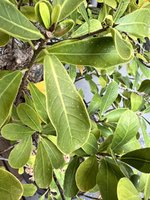I believe those white dots are cystoliths
https://www.ncbi.nlm.nih.gov/pmc/articles/PMC5813535/ which are very common across many ficus species. I've just taken a quick look at a couple of F natalensis and only a few of the leaves have them here (visible cystoliths), I suspect they are more apparent on your tree due to reacting to change in your tree's environment.
As the linked paper suggests, part of the function of cystoliths could be to help regulate photosynthesis. One suggestion (not saying this is fact) is that your leaves are doing this as a reaction to the change in light conditions.
In my personal experience F natalensis prefers partial shade. They are just happier and I get more growth. <-- This may not be true for everyone, because it's based on my local environment in sunny Sydney Australia.
My guess would be the tree is in shock from being moved inside to outside and is reacting. There is a possibility it is not happy with the amount of sunlight it is getting, but some may argue it could drop all its leaves and be happy again. As mentioned above, this is a local environment thing and you would need to use your own experience to make a call on if less direct sunlight is suitable. My third suggestion is watering: how confident are you that you've adequately adjusted the watering pattern for this tree to accommodate the shift from inside to outside? Final suggestion is whether or not when it was transplanted that it was planted in the ground appropriately? If there are pockets of air near the roots or the tree was bare rooted and placed into crappy soil etc. etc. that may have affected the ability of the tree to take in water or settle into its new location while it is simultaneously trying to adjust to the new levels of sunlight.
* Edit: Lack of sleep, it kinda looks like it is still in a pot and not in the ground. So I will change my last suggestion to whether or not it was repotted or had root work done at the time the tree was moved outside?


